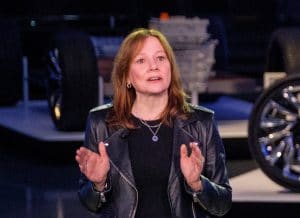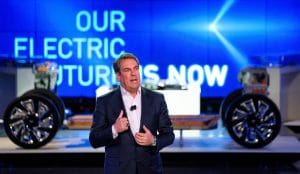
For GM CEO Mary Barra, Wednesday’s deep-dive on EVs marked “an historic occasion.” For Wall St., it was just another day.”
During a series of meetings this week, General Motors officials – including CEO Mary Barra and Pres. Mark Reuss – set out to convince both the news media and Wall Street that the company’s $20 billion bet on the future of mobility is on the right track.
As she has done numerous times in recent months, Barra declared that GM is “on a path to an all-electric future,” spending $20 billion by 2025 to develop both EVs and autonomous vehicles – with 20 all-electric models coming by 2023 and “many more” to follow. For his part, added Reuss, “This is the biggest opportunity any of us has ever seen for this company.”
Wall Street has rewarded Tesla for a far smaller effort, the California upstart’s stock price surging to nearly $1,000 in recent weeks – and market value reaching triple that of GM’s – before settling back as the impact of the coronavirus unnerved investors.
Barra on Wednesday clearly showed her frustration, declaring “I think General Motors is undervalued. I really do,” during the media background session that began the day. As she began preparing for a second meeting with analysts to follow, she struck the more upbeat tone she would need to sell investors, asserting that, “We’re bringing the power and might of General Motors” to bear as the company’s EV effort rapidly moves forward.
(GM reveals a dozen of the many EVs it will bring to market by 2023.)
There were clearly some strong messages during both sessions about how GM expects its EV program to pay off. For one thing, it predicts its battery prices will soon drop to $100 per kilowatt-hour — or less — down from $1,000 a decade ago, when it launched the Chevrolet Volt plug-in hybrid, and $145 when the Chevy Bolt EV debuted in late 2016. On a vehicle like the Bolt, with a 60 kWh pack, that would save thousands of dollars and bring the vehicle much closer to being on par with the price of a comparable gasoline-powered model.
One way the automaker hopes to get there is with the $2.3 billion battery plant it is setting up near Lordstown, Ohio in partnership with LG Chem, the Korean battery maker already supplying products like the Volt. The second-generation plant is expected to achieve significant improvements in productivity, never mind the benefits of an improved battery design that, among other things, all but eliminates the need for costly cobalt.
And GM also says its new battery module and pack designs will slash the need for copper, increase flexibility and further reduce costs.
GM also outlined ways it expected to slash manufacturing costs. For one thing, it will simplify plant operations by cutting from 550 to just 19 the number of powertrain variants it will offer with its EVs. Indeed, a recent study by AlixPartners estimated that the time needed to assemble an EV would drop to an average 3.7 manhours, down from 6.2 for that comparable gas model. That’s in Europe, though the lead analyst said the study should translate into similar results for the U.S.
“Everything you see here is real,” said Reuss, as he led reporters – and, later, analysts, out across the floor of the GM Design Dome at its Technical Center in Warren, Michigan, to explore the new technologies on display, along with about a dozen future battery-electric vehicles.

“Everything you see here is real,” GM Pres. Mark Reuss told reporters. and, later, Wall Street analysts.
The presentation played well among the media and appeared to win over at least some of the analysts who attended later in the day.
Referencing GM’s new Ultium batteries, J.P Morgan’s Ryan Brinkman said in a report to clients, “we estimate (they) are at least on par with or even exceed that of the most advanced competition.”
More broadly, “GM’s EV day should help show investors that GM is serious about decarbonization and has a strong plan,” RBC analyst Joe Spak wrote in his own research report.
Spak has set a stock price of $49 for GM shares, well above the $41.90 high that it reached during the past 52 weeks. That and upbeat forecasts from Brinkman, Benchmark’s Mike Ward and others might have quickly set off a flurry of buying, much as seems to happen following a positive report – or even a comment on television – for Tesla.
But, if that was what Barra and Reuss were expecting, they are in for more disappointment. GM shares did spike late Wednesday, but only to a closing price of $31.53, up from $30.52 at the end of the day Tuesday. And, by the time trading resumed on Wall Street Thursday morning, the gains were wiped out.
(GM’s next-gen EVs will be able to charge as fast as you can fill your gas tank.)
As Barra suggested, this might be “an historic moment for GM,” but investors so far seem to be seeing the same-old-same-old and appear less impressed, even than normally jaded automotive analysts and media.
It probably doesn’t help that the reality of the U.S. EV market isn’t very encouraging. Include all forms of battery-based propulsion and those vehicles accounted for barely 5% of total new model sales in 2019, with all-electric products roughly flat at around 1%. Tesla overwhelmingly dominates the sales charts and, as a senior GM marketing executive confided to TheDetroitBureau.com, it has the unique presence of CEO Elon Musk to help win over buyers, as well as investors.
“There is a fanatical fanboy base for Tesla which has lived up to expectations” when it comes to most of its promises, said Joe Phillippi, head of AutoTrends Consulting.
GM’s own long-range EV, the Chevrolet Bolt, is far down the sales charts from the similarly sized Tesla Model 3. The big question is whether any of the Detroit maker’s upcoming models will fare any better.
In a lengthy conversation, GM President Reuss acknowledged the challenges the company faces, but insists that GM has the fundamental power to finally kick-start demand as all its new models start rolling into showrooms.
That tsunami will begin soon with the all-new GMC Hummer pickup – and similar SUV – the Cadillac Lyriq crossover and an extended-length Chevy Bolt over the coming year. Other new models will follow in ever-quicker succession. And how they do in the marketplace likely will be the factor that investors will be watching.
“Without a doubt, the proof will be in the sales numbers,” said Phillippi.
(GM building up EV charging network for employees.)


